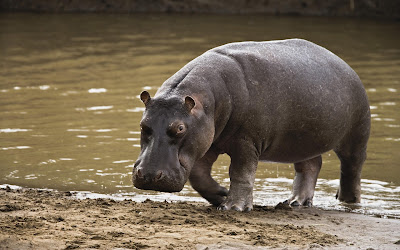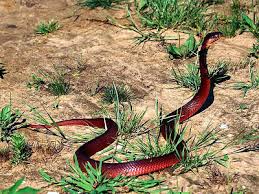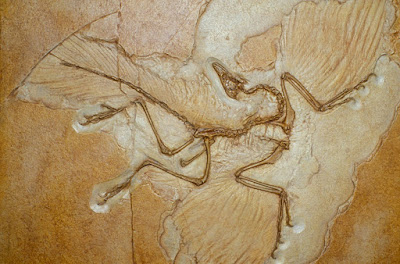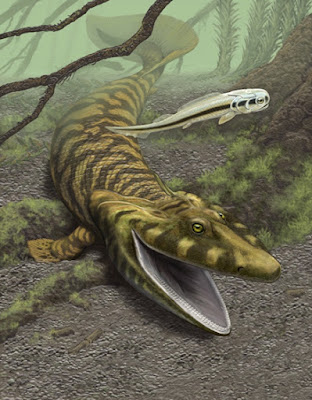Shark Family
Shark Family
Cartilaginous fish are generally designed by nature to be
stealthy predators, usually hunting other fish but also preying on
invertebrates, reptiles, birds and mammals when the chance arises. Most species
live in marine habitats only, although a few have adapted to cope with brackish
water and fresh-water. The fish of the chondrichthyes class all have skeletons
made from cartilage, rather than bone cartilage is a flexible material
containing collagen, which is also present in bone alongside brittle calcium
compounds. Members of the shark family, therefore, have tough and bendable
skeletons.
Giant Sharks
The largest shark species is the whale shark (Rhincodon typus),
which can grow in excess of 12m (39 ft.) and lives in the open ocean. Despite
its size, the whale shark is a benign fish as it has adapted to eat plankton by
filtering it from seawater. Plankton can comprise all seawater of small
organisms in adult or larval form. The term zooplankton describes plankton
consisting of animal species, while phytoplankton is the term used for plankton
consisting of microscopic marine plants. A similar, but smaller species is the
basking shark (cetorhinus maximus). While the whale shark and basking shark
filter feed at, or near the ocean surface during the day, a third species, the
mega-mouth shark (Megachasma pelagios), filters the water at night. It is even
equipped with luminous lures around its mouth to attract larger prey, which
swim towards the light. Due to their overall form, it is possible to tell that
these filter feeding species have descended from predatory ancestors, but
evolved to fill ecological niches that were hitherto unexploited.
Typical Sharks
Typical sharks have changed very little from ancestors that
lived tens of millions of years ago. This is because their design had already
been perfected by the process of natural selection, so the passage of time has
seen modern species change in only minor ways, according to specific
lifestyles. Typical species include the great white shark (carcharodon
carcharias), the tiger shark (Galeocerdo cuvier), the blue shark (Prionace
glauca), the mako sharks (genus Isurus) and the reef sharks (genus
Carcharhinus). All of these species are built with speed and efficiency for
chasing down and dispatching prey. They have torpedo- shaped bodies with
powerful tails for propulsion and blade- like fins for precise steering
maneuvers.
The ability to move apace through water is known as
hydrodynamics and works in a similar way to the aerodynamics of birds of prey
flying through air. The idea is to create as little resistance as possible, so
that energy is not wasted and momentum is maintained. Even the shark`s skin is
adapted to reduce water resistance or drag. It has a rough texture that traps a
layer of water, so that the shark is effectively lubricated as it moves
forwards. The mouth of the typical shark is also well designed for its job. It
is set beneath the nose of the fish. For large prey, the jaws extend to ensure
that a good bite is achieved. Inside the mouth there are concentric rows of
razor sharp teeth. They work in the manner of a tank- cutting saw, removing
bite- sized chunks from the victim as the shark rotates its mouth by twisting
from side to side. Sharks are able to detect their food in two ways:-
1. They have very sensitive
chemical receptors (chemoreceptors) that can taste or smell the water, alerting
them to the presence of blood from injured prey. Similarly, they can detect
chemicals given off by other injured sharks and will quickly flee from danger
if the situation arises.
2. Many sharks can detect
the tiny electromagnetic pulses produced by the muscles in prey animals. They
scan the seabed in a similar way to a metal detector and strike when they home
in on the electrical signals. This makes it possible to detect animals hidden
in the mud or sand. The experts at this type of hunting are the hammerhead
sharks. They have widened heads to increase the surface area of the skin
carrying the electro-receptors or ampullae. As they cannot always see the prey
they have detected, they rely instead on touch and agility to locate and eat
them.
Rays and Skates
The rays and skates are fundamentally similar to sharks, except
that their bodies have typically become flattened to suit life spent largely on
the seafloor. They are often camouflaged to match their chosen background as
they are preyed upon by sharks and other marine animals. Some are armed with
poisonous spines to deter would be attackers. There are also species called
ghost, or elephant sharks. The first name alludes to their iridescent and
faintly luminous skin. The second alludes to their nose, which bears some
resemblance to a baby elephant. They are also known variously as chimaeras,
ratfish and rabbit fish. In scientific terms, they share features with sharks, rays
and skates, but they also have a number of dissimilarities.
Reference
Also See
• Parrots
• Bats
• Bears
• Birds
©
Don`t Kill Creatures of
Nature, You have No Right to Do That
Being Vegetarian, Love
Creature of Nature
Live and Give Space for
another Life
Save Nature
Love Nature


















Very informative article.
ReplyDelete